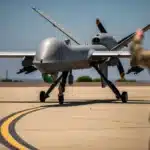Contemporary warfare has undergone a transformation, merging the actual and perceived power of artificial intelligence (AI) with age-old conflicts that have afflicted humanity for centuries. This shift is vividly observed in the ongoing struggle between Israel and Palestine, a situation where the deployment of targeting AI by the Israeli Defense Forces (IDF) is used to justify a significant change in the rules of warfare. Battles that were once fought by soldiers on clearly defined fields have now morphed into a struggle where algorithms and machines are as influential as human decisions.
This development has not only enhanced the destructive opportunities of the IDF but also raises the conflict to a realm where “sacred violence”—acts of war charged with deep meanings and often justified by religious or ideological narratives—is intensified by the precision and impersonality of technology.
Automatically determined targets can make AI an alibi generator cynically justifying war crimes.
This article delves into the profound implications of AI’s integration into the Israel-Palestine conflict, examining how this technological advancement has reshaped the ethical landscape of warfare and blurred the lines between combatants and civilians. By analyzing the strategic use of AI by the IDF, it aims to explore the erosion of traditional ethical norms, the transformation of warfare into a realm of “sacred violence,” and the wider consequences for international law and human rights.
Through this analysis, I seek to illuminate the intricate interplay between technology, ethics, and the enduring human pursuit of justice and peace amidst conflict.
Ethical Degradation in Military Strategy
Traditionally, military operations adhered to strict ethical codes, with a strong emphasis on protecting civilian lives. Yet, as AI increasingly infiltrates military tactics, we are witnessing a significant erosion of ethical standards.
AI technologies, crafted for maximizing operational effectiveness, lack the innate capacity for ethical reasoning that human commanders possess. Their utilization in critical aspects of military operations, such as targeting, surveillance, and engagement, has obscured the distinctions between combatants and non-combatants. And even where it is clear, automatically determined targets can make AI an alibi generator cynically justifying war crimes. This shift not only strays from the established ethical norms of military conduct but also poses a challenge to the safeguarding principles of international humanitarian law.
The adoption of algorithm-based decision-making introduces an impersonal element into decision-making processes once dominated by human empathy and moral judgment. Incidents of AI-guided actions causing harm to civilians emphasize the critical need to reconsider the ethical ramifications of warfare driven by technology. The diminishing value placed on civilian lives, viewed through the impartial lens of AI, raises fundamental concerns about the ethical integrity of warfare practices.
With the expanding role of AI in military contexts, there emerges an urgent need to weave ethical considerations into the fabric of technological development and its application in warfare. The challenge is to ensure that technological progress not only complies with but also reinforces the principles of civilian protection mandated by international laws and standards.
The Blurred Line Between Combatants and Civilians
The introduction of AI technologies in warfare, particularly through systems like IDF’s targeting program “Gospel,” has significantly obscured the traditional distinctions between combatants and civilians. This development introduces profound concerns regarding civilian safety and challenges the foundational norms of international armed conflict.
“Gospel,” engineered for heightened efficiency (not necessarily precision) in the identification and engagement of targets, relies on intricate algorithms that process extensive data to make immediate decisions. This dependence on technology during combat complicates established military ethics and blurs the definitions of legitimate targets.
The objective should be to ensure that technological progress does not undermine human rights and dignity.
When AI is making targeting decisions, the line between combatants and non-combatants becomes increasingly indistinct. Such ambiguity not only escalates the risk to civilian lives but also confronts the principles of distinction and proportionality, essential tenets of the laws of war designed to minimize civilian harm.
The high number of of civilian casualties in these AI-directed operations underlines the pressing necessity to reassess the incorporation of these technologies into military tactics. The use of “Gospel” and other AI systems stretches the limits of international legal frameworks intended to safeguard civilian populations in areas of conflict.
With the ongoing advancement and increasing prominence of AI in military contexts, it’s imperative for the global community to address these ethical and legal challenges. The objective should be to ensure that technological progress does not undermine human rights and dignity. It’s vital that AI development in warfare adheres to ethical standards and prioritizes civilian protection.
Sacred Violence: Necrotactics and the Hannibal Directive
The use of necrotactics by Isreal—where killing “enemies” supplants all other tactical considerations, along with strategies of domicide, urbanicide, and apartheid, marks the end of any claim of moral war fighting by the IDF. These approaches combined with changes in the IDF ethical codes and integrated into Israel’s military objectives now increasingly based on ancient religious claims, have led to a mode of engagement that extends beyond simple territorial or political aims, infusing operations with a depth and sanctity of purpose that is used to justify ignoring International Humanitarian law.
The tactics of domicide and urbanicide surpass typical military goals, venturing into the territory of sacred violence.
The Hannibal Directive, allowing for drastic actions to prevent the capture of Israeli soldiers even at the risk of harming those soldiers, emphasizes the profound importance attributed to thwarting enemy successes at any cost. This policy has precipitated scenarios where extensive destruction is unleashed, often impacting civilians and permanently altering urban environments. Prioritizing continued military operations with the massive killing of Palestinian civilians over the recovery of the Israeli hostages seized in the terror attack of October 7 by Hamas, is the logical extension of the Hannibal Directive.
Likewise, the tactics of domicide and urbanicide—intentional obliteration of homes and cities—surpass typical military goals, venturing into the territory of sacred violence. These acts seek to eliminate more than mere physical edifices; they aim to dissolve the identity and heritage of the adversary, thus attempting to dilute the Palestinian community’s collective and historical ties through strategic and symbolic annihilation.
The adoption of apartheid-like measures, which segregate populations, limit movement, and discriminate based on ethnicity, further embodies sacred violence. These strategies strive not only for control but also for the sanctification of division, portraying it as an essential defense of national identity and survival.
Incorporated into the larger narrative of the Israel-Palestine conflict, these tactics unveil an unequal dialogue between conventional military strategies and the exercise of sacred violence. This sanctity is rooted not in divine ordinance but in a fervent belief in the justness of the cause and the ethical imperative to prevail, regardless of the moral and human costs involved. As the conflict unfolds, the ramifications of these necrotactics on societal fabric and the pursuit of peace are profound, posing ethical challenges for the global community in addressing sacred violence within the framework of contemporary warfare.
Postmodern Terror Warfare: Merging of Terror and Technology
The arena of conflict has experienced a dramatic shift, moving into the domain of postmodern terror warfare, a realm characterized by the novel intersection of terror and technology. This evolution has significantly changed the nature of warfare, affecting assailants and victims alike, and fostering a seemingly endless cycle of violence and retaliation.
Street assaults, drone strikes and cyber-attacks can occur without warning.
In this era of postmodern warfare, the objectives extend beyond mere territorial conquests or traditional military triumphs. Warfare has increasingly embraced the use of terror as a psychological weapon, aimed at instilling fear, undermining morale, and pressuring governments into submission. The integration of cutting-edge technologies, especially AI, has expanded the scope and effectiveness of terror tactics, allowing for violence that is simultaneously highly specific and indiscriminately widespread.
For the aggressors, be they state entities like the IDF or non-state groups such as various Palestinian factions, technology presents an enticing opportunity to fulfill their agendas with unparalleled accuracy while minimizing exposure to their own forces. However, this technological dependency also strips away the personal nature of violence, alienating the perpetrator from the repercussions of their actions and, to a certain extent, numbing them to the consequences of their choices.
Victims caught in the web of postmodern terror warfare are thrust into an environment of constant uncertainty for civilians, because street assaults, drone strikes and cyber-attacks can occur without warning. The arbitrary nature of these strategies, combined with the challenge of predicting or effectively countering them, engenders a widespread sense of vulnerability and apprehension among civilians. This climate of fear not only disrupts the everyday lives of individuals in conflict-ridden areas but also poses significant challenges for the global community in addressing and alleviating such violence.
Strategic Outcomes: Triumphs in Battle, Defeats in War
Israel’s steadfast pursuit of technological superiority and aggressive military policies, while tactically beneficial in the short run, casts a long shadow over its strategic and ethical horizons. Rooted in a complex history of colonial expropriations and propelled into the present by a zeal for biblical fundamentalism and cutting-edge military technology, particularly AI, these strategies signal a profound ethical degradation within the IDF. This shift is not isolated but part of a broader narrative that encompasses collective punishment, disproportionate responses, targeted assassinations, and actions amounting to ethnic cleansing in Gaza.
Can a path be forged that aligns military capabilities with ethical imperatives and strategic foresight?
At the heart of this evolution is Israel’s embrace of AI in warfare, a move that, while innovative, has amplified its commitment to strategies that blur ethical lines and push the boundaries of international law. The IDF’s policies, including the modified Principle of Distinction, the Momentum plan, and reliance on systems like the AI targeting program “Gospel,” reflect a deepening entrenchment in military tactics that prioritize immediate victories over long-term peace and ethical considerations.
These strategies, underpinned by a belief in the supremacy of technological warfare, have led to widespread international condemnation. The approach of targeting not just Hamas leaders but also the broader Palestinian society through indiscriminate force and acts that challenge the very essence of international humanitarian principles, risks isolating Israel on the global stage. As the international community grapples with the implications of these actions, the stark reality emerges: Israel’s tactical successes are overshadowed by strategic and ethical failures.
In this complex landscape of modern warfare, where technology and ancient narratives of sacred violence converge, the implications extend far beyond the immediate conflict. The pursuit of victory through overwhelming technological force and disregard for ethical norms not only jeopardizes Israel’s moral standing but also its long-term strategic objectives. As we reflect on these developments, the critical question arises: can a path be forged that aligns military capabilities with ethical imperatives and strategic foresight, or will the cycle of violence and resistance continue unabated, fueled by the very technologies meant to secure peace?
Conclusion and Final Reflections
Exploring the evolving dynamics of warfare, especially in the context of the Israel-Palestine conflict, underscores the critical need for technological advancements to be in harmony with ethical and humanitarian principles. This analysis brings into sharp relief a striking contrast: the rapid progression of military technology, particularly AI and its significant impact on warfighting, juxtaposed against the timeless principles of human dignity, justice, and civilian protection enshrined in international law.
The challenge extends beyond mere technological restraint to encompass ethical foresight. The adoption of AI in military strategy, while providing new powerful capabilities, also poses deep questions regarding the nature of conflict, the value of life, and the essence of human judgment amid the chaos of war. The use of technologies by the IDF, such as the AI targeting system “Gospel” and strategies that obscure moral boundaries, brings urgency to these issues.
In addressing this complex issue, the international community must ensure that warfare tools are employed with a profound sense of responsibility and adherence to humanity’s principles. This involves a diligent examination of the ethical implications of emerging military technologies and a concerted effort to maintain the standards of international humanitarian law in the face of technological allure.
Additionally, the quest for peace and justice in contemporary conflicts requires a vision that goes beyond the immediate tactical benefits offered by technological innovations. It necessitates a comprehensive approach to conflict resolution that tackles the root causes of violence, promotes dialogue and understanding, and aims to bridge divides rather than widen them.
Reflecting on the Israel-Palestine conflict and AI’s role in its trajectory, it’s vital to reaffirm our commitment to justice and peace. In doing so, we highlight the importance of ethical considerations in military technology deployments and emphasize the need for solutions that not only resolve conflicts but also pave the way for a more just and peaceful world. Bridging technological prowess with humanitarian values is not a choice but a necessity for a future where every individual’s dignity is respected, and the shadow of sacred violence is dispelled.
Adapted from an academic article for a wider audience, under license CC BY 4.0.









